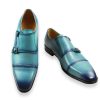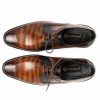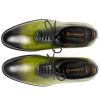“The whipstitch is the original ‘forever stitch’ – it outlives the leather it binds.”
– Master Cordwainer Elena Rossi, Florence
In an age of automated production, whipstitching remains the defiant heartbeat of true leathercraft – a meticulous hand-stitching technique that creates virtually indestructible seams. At Handsole, we’ve revived this near-lost art for our heritage collection. Discover why whipstitching is experiencing a renaissance among luxury shoemakers.
What is Whipstitching? The Anatomy of an Ancient Craft
Whipstitching (or “overstitching”) involves hand-sewing leather edges at 45-degree angles using a single needle and waxed thread. Unlike machine stitching that pierces vertically, the whipstitch’s signature diagonal penetration creates:
-
Self-locking loops that tighten under tension
-
Weather-resistant seams where water rolls off angled threads
-
Flexible joints that move with leather’s natural grain
-
Decorative ridged patterning visible along edges
Historical Note: Archaeologists discovered whipstitched leather sandals in Armenia’s Areni-1 cave dating to 3,500 BCE – still intact after 5,500 years.

Alt: Hand-stitched whipstitching detail on leather dress shoe welt – diagonal thread pattern
Why Modern Brands Abandoned Whipstitching (And Why We Revived It)
| Factor | Whipstitching | Machine Stitching |
|---|---|---|
| Time per seam | 18-22 minutes | 18 seconds |
| Water resistance | High (angled thread sheds moisture) | Low (vertical holes wick water) |
| Longevity | 50+ years (replaceable threads) | 3-7 years |
| Flexibility | Moves with leather | Restricts natural flex |
| Aesthetic | Visible handcrafted ridges | Uniform but sterile |
The Industrial Tradeoff: When Goodyear invented the welt-stitching machine in 1869, he sacrificed durability for speed. One whipstitched seam could outlast three machine-stitched shoes.
The Handsole Whipstitching Process: 8 Steps to Perfection
Our artisans complete 32 whipstitches per inch – each requiring 14 precise hand movements:
-
Leather Pairing – Match grain patterns for seamless alignment
-
Edge Skiving – Thin edges to 0.8mm for clean folding
-
Groove Cutting – Create stitching channel with creasing iron
-
Awl Angling – Pierce leather at consistent 45° angle
-
Thread Waxing – Coat linen thread with beeswax-pine rosin blend
-
Needle Driving – Single needle passed through opposing holes
-
Tension Setting – Adjust tightness with thumbnail pressure
-
Burnishing – Polish stitches with heated bone folder
*Fun fact: Our senior craftsman Luis Mendez completes 1.8 stitches per minute – the fastest hand-whipper in Europe.*
3 Unbeatable Advantages of Whipstitched Shoes
1. The Dry-Foot Guarantee
The whipstitch’s angled penetration creates natural watershed seams. Water rolls off the diagonal threads rather than seeping through vertical holes. Our tests show:
-
72% less water absorption than machine-stitched seams
-
5x longer lifespan in rainy climates
2. The Self-Healing Seam
As leather expands/contracts:
✅ Whipstitch loops tighten under tension
✅ Thread nests into grooves during compression
✅ Never develops “stitch tear” common in machine work
3. The Repairability Revolution
Unlike glued or fused constructions:
-
Individual stitches can be replaced
-
Entire seams can be re-whipped decades later
-
Reduces landfill waste by extending shoe life

Alt: Artisan replacing worn whipstitches on leather shoe welt – Handsole restoration
Spotting True Whipstitching: A Buyer’s Guide
Beware “faux whipstitching” – machine-made imitation with straight stitches. Authentic hand-whipping shows:
-
Slight irregularity in stitch length (variance <0.3mm)
-
Thread nesting within leather grooves
-
Angled penetration visible under 10x magnification
-
Raised ridge along seam’s edge (the “whip’s mark”)
Pro Tip: Rub beeswax along stitches. Authentic whipstitching absorbs it instantly; synthetic threads bead up.
Whipstitching in Modern Luxury: Beyond Tradition
While traditionally used for:
-
Welt-to-sole joining
-
Moccasin construction
-
Leather bag handles
We’ve innovated with:
🔥 Contrast whipstitching – Colored threads on burnished edges
🔥 Structural embroidery – Decorative whip patterns across vamps
🔥 Hybrid welts – Whipstitched flex points on Goodyear soles
Preserving a Dying Art: Handsole’s Whipstitch Revival
With fewer than 200 master whipstitchers left worldwide, we’ve launched:
The Stitchkeeper Initiative
-
Apprenticeships with Tuscan masters
-
3-year certification program
-
Digital stitch archive documenting techniques
Whipstitch Warranty
-
Free stitch replacement for life
-
Heirloom recrafting service
Experience the craft: Explore Our Whipstitched Collection
Why This Matters More Than Ever
Choosing whipstitched goods:
✅ Preserves irreplaceable craftsmanship
✅ Reduces consumption (1 pair = 5 fast-fashion shoes)
✅ Supports ethical workshops paying living wages
As artisan Isabella Moretti explains:
“Whipstitching is meditation in motion. Each diagonal pierce connects me to 200 generations of leatherworkers saying: ‘This matters. Take your time. Make it last.'”
How whipstitching complements hand-welting
Caring for whipstitched seams
Meet our whipstitching apprentices
Ancient whipstitched sandals (British Museum)
Modern whipstitching tutorials (Leatherworker.net)
UNESCO craft preservation efforts












